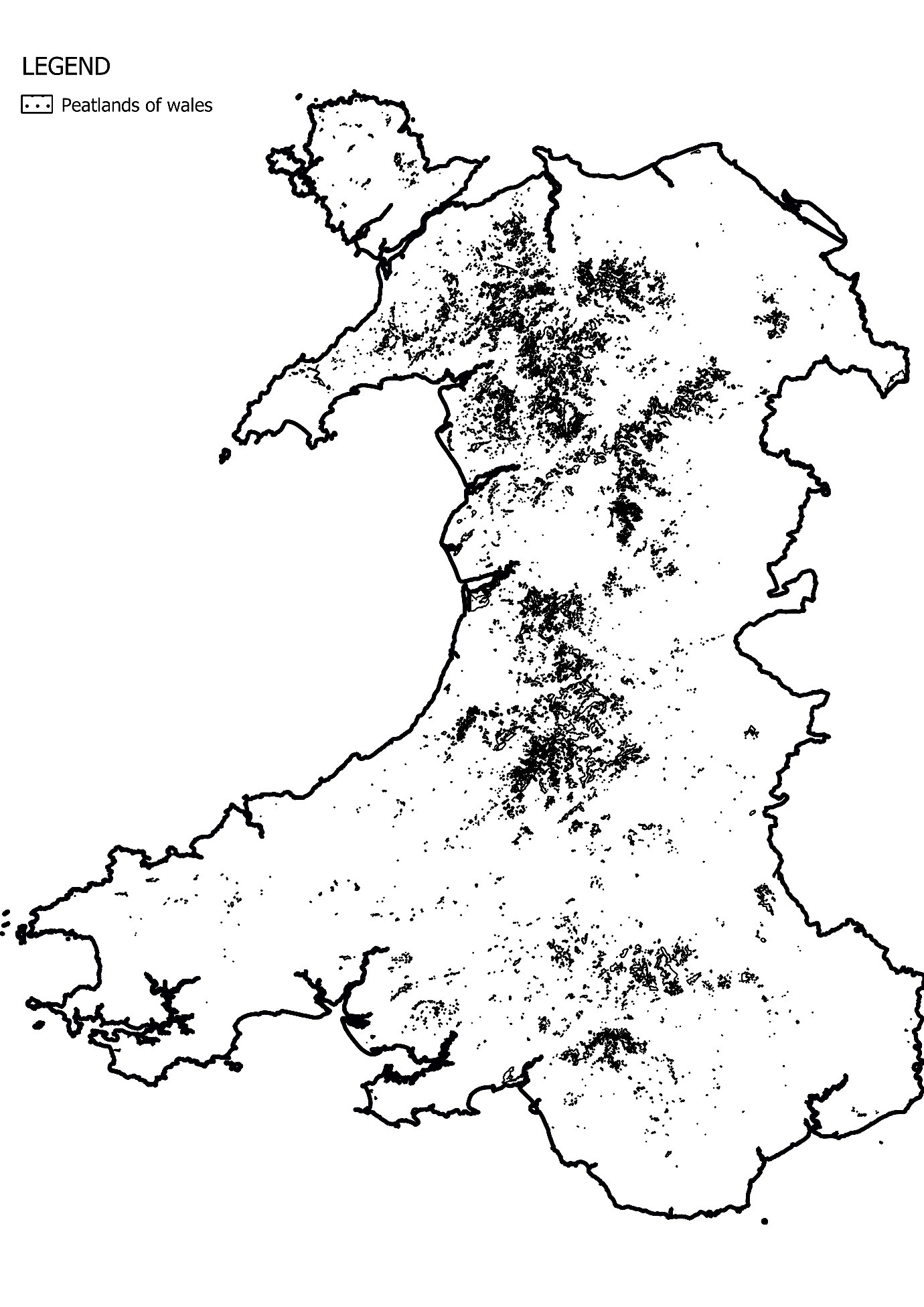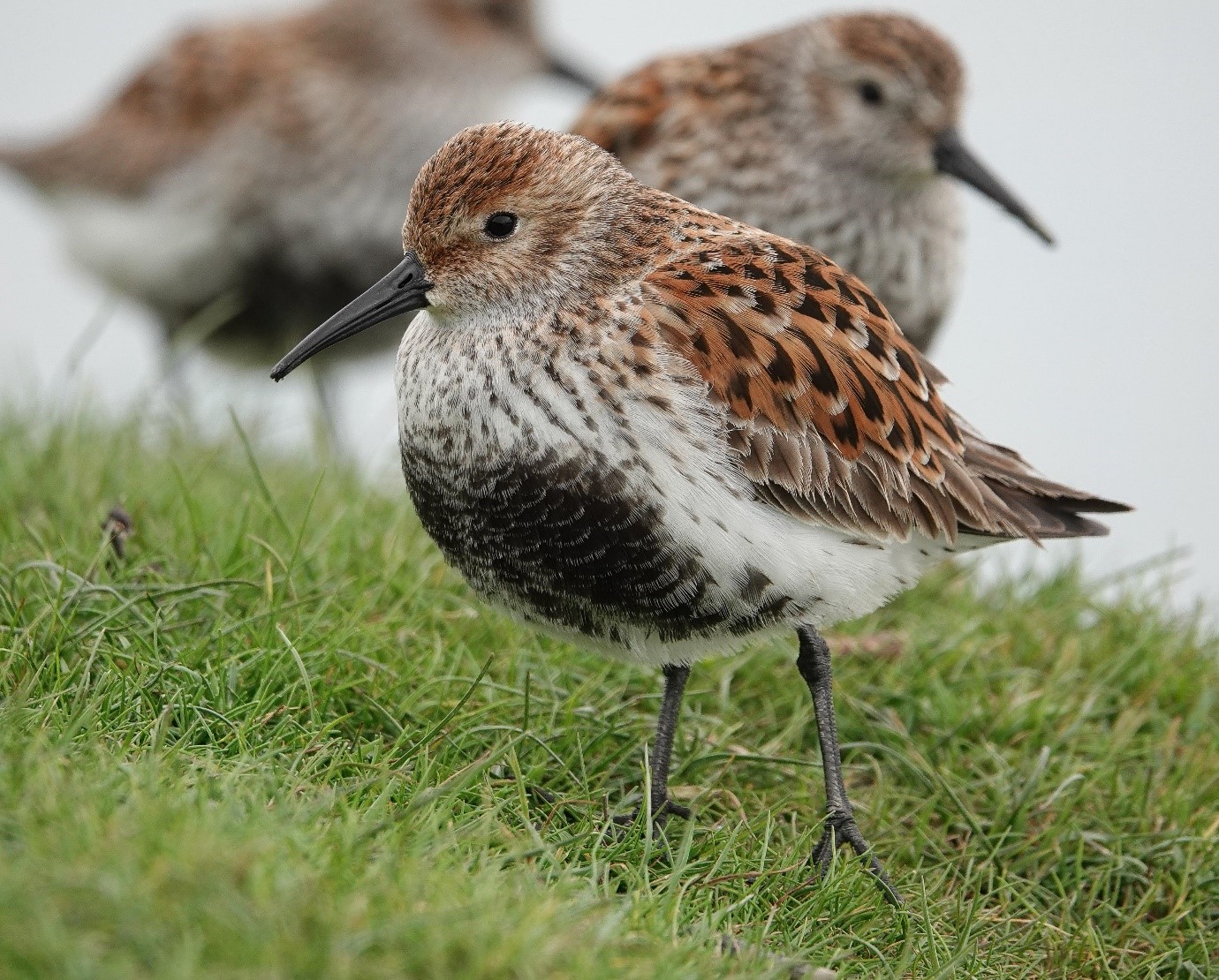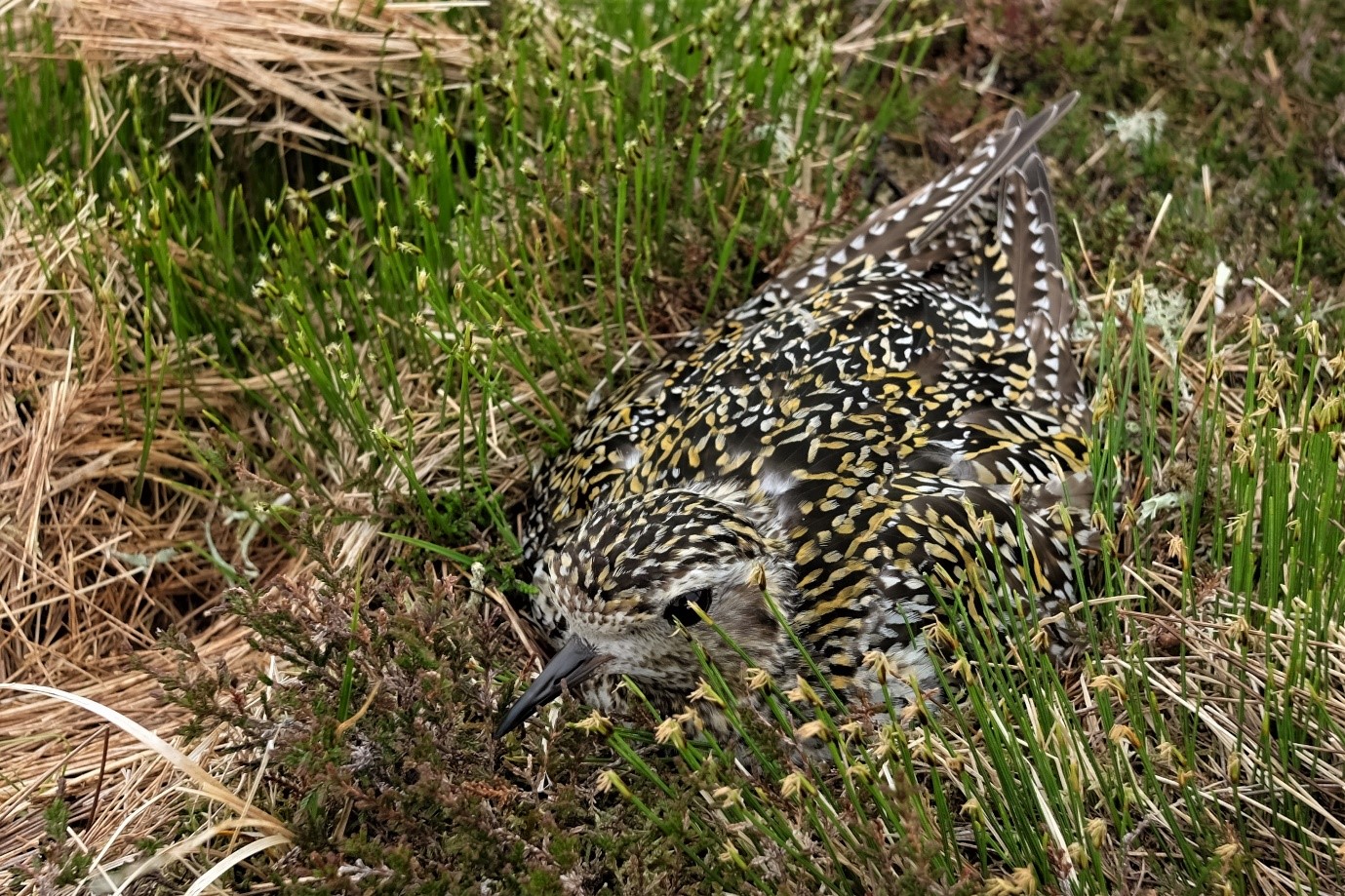Rhagarweiniad
Mae mawndiroedd, a nodweddir gan grynhoad o sylweddau organig mewn amgylcheddau llawn dŵr, yn chwarae rhan hanfodol wrth gynnal bioamrywiaeth fyd-eang a storio carbon. Mae'r ecosystemau unigryw hyn yn darparu cynefin i amrywiaeth o rywogaethau planhigion ac anifeiliaid, gan gynnwys adar. Fodd bynnag, mae mawndiroedd ledled y byd wedi dirywio'n helaeth oherwydd draenio, amaethyddiaeth, a gweithgareddau dynol eraill. Mae adfer mawndiroedd wedi dod i'r amlwg fel strategaeth lleihau allyriadau hanfodol ar y tir[1], ac mae'n cael ei wneud yn eang yng Nghymru. Ond beth fydd effaith yr adferiad hwn ar y gymuned a'r poblogaethau adar yng Nghymru? A sut mae hyn yn cydbwyso yn erbyn effeithiau tebygol newid yn yr hinsawdd ar adar Cymru?
Mawndir yng Nghymru
Mae Cymru'n cynnal tua 120,000 hectar o briddoedd mawnog, y mae cyfran fawr ohonynt mewn cyflwr anffafriol[2]. Mae hyn yn cynnwys ardaloedd o ffen yr iseldir a chyforgors fel Cors Caron a Chors Fochno. Er, mae llawer ohono'n cynnwys gorgors yr ucheldir sy'n gorchuddio asgwrn cefn Cymru. Ceir hyn yn siroedd Gwynedd, Ceredigion a Phowys ac mae'n ymestyn mor bell i'r de â Bannau Brycheiniog ac ardaloedd ucheldirol Morgannwg (Ffigur 1).
Mae'r gydnabyddiaeth ddiweddar o bwysigrwydd mawndiroedd ar gyfer lleihau allyriadau wedi arwain at newid polisi Llywodraeth Cymru. Mae Polisi Mawndiroedd tymor hir Llywodraeth Cymru (Adroddiad am Benderfyniad Gweinidogion Llywodraeth Cymru, 26 Mehefin 2019) yn uchelgeisiol ac yn canolbwyntio ar (i) sicrhau bod "yr holl fawndiroedd â llystyfiant lled-naturiol yn cael eu rheoli/hadfer mewn modd ffafriol (ardal amcangyfrifedig o o leiaf 30,000 hectar)", a (ii) adfer "o leiaf 25% (~ tua 5,000 hectar) o'r ardaloedd mawndir sydd wedi'u haddasu fwyaf"..
Amcangyfrifir ar hyn o bryd fod ~ 18,000 hectar o fawn dwfn yng Nghymru wedi'i goedwigo y mae ~ 11,000 ha yn eiddo i Lywodraeth Cymru (LlC). Felly, mae dwy elfen wahanol i adfer mawndir yng Nghymru; adfer mawndir agored ac, adfer mawndir drwy newid coedwig yn gors, gydag adfer o goedwig i gors ar ystâd goetir LlC yn cynnig cyfle sylweddol i'w gyflwyno'n gyflym[3].

Ffigwr 1 - Mawndiroedd Cymru. Mae'r map hwn yn dangos ardaloedd lle mae priddoedd yn debygol o gynnwys >40cm o ddyfnder mawn.
Adar y Mawndir yng Nghymru
Mae llawer o rywogaethau sy'n bridio ym mawndiroedd Cymru'n cael eu cydnabod yn bwysig yn rhyngwladol a rhoddir dynodiadau ac amddiffyniad cyfreithiol iddynt. Mae gan orgorsydd, cyforgorsydd yr iseldir a ffeniau i gyd gasgliadau o adar gwahanol. Fodd bynnag, mae casgliad adar bridio gorgorsydd y DU yn neilltuol. O fewn gorgorsydd, mae'r cynefinoedd gwlypaf (pyllau agored a chors heb ei draenio) yn aml yn cael eu defnyddio gan adar gwyllt a phibyddion y mawn Calidris alpina, tra mae ardaloedd o lystyfiant tal (yn aml mewn mosaigau sy'n cynnwys rhostir ucheldirol) yn darparu safleoedd i gysgodi a nythu ar gyfer y rugiar ddu Lyrurus tetrix, y gylfinir Numenius arquata, y boda tinwyn Circus cyaneus a'r cudyll bach Falco columbarius[4]. Mae'r cwtiad aur Pluvialis Pluvialis, y pibydd coesgoch Tringa totanus a'r ehedydd lauda arvensis hefyd yn aml yn bresennol sy'n gysylltiedig â llystyfiant byrrach[5]. Mae'r niferoedd bach o bibyddion y mawn sy'n bridio yng Nghymru (Ffigur 2 a 3) bellach wedi'u cyfyngu i raddau helaeth i fawnogydd a rhostiroedd gwlyb yn ein gorgorsydd ucheldirol o'r ansawdd gorau.
Newid yn yr Hinsawdd ac Adar
Mae'n debygol y bydd effeithiau newid hinsawdd ar adar yng Nghymru'n gymysg[6]. Bydd llawer o adar preswyl cyffredin ac sydd i’w cael dros ardal helaeth yn cael eu helpu gan y bydd llai o risg y byddant yn marw mewn tywydd oer yn y gaeaf, ond mae'n debygol y bydd ein casgliad unigryw o rywogaethau adar yr ucheldir, sy'n cynnwys y rheini sy'n gysylltiedig â mawndiroedd, ar eu colled yn fawr oherwydd newid yn yr hinsawdd. Mae hyn yn cynnwys rhywogaethau fel y cwtiad aur a phibydd y mawn, y bydd hafau sych, poeth yn lleihau'r doreth o ysglyfaeth ddi-asgwrn-cefn allweddol (e.e. teulu'r Tipulidae), gan effeithio ar lwyddiant bridio a thrywydd poblogaeth y rhywogaethau hyn[7].
Mae'r cwtiad aur (Ffigur 4 a 5) a phibydd y mawn ill dau wedi dirywio'n ddramatig fel adar sy'n bridio yng Nghymru, gyda gostyngiad o o leiaf ~40% yn niferoedd y pibyddion aur sy'n bridio ers 1975 a gostyngiad o 88% yn niferoedd y cwtiaid aur sy'n bridio[8]. Roedd y ddwy rywogaeth yn gysylltiedig yn draddodiadol ag ardaloedd asgwrn cefn ucheldirol Cymru ac mae’r cynnydd cyffredinol yn nhrechedd glaswellt y gweunydd, Molina caerula (o bosib o ganlyniad i ddirywiad mawndiroedd) wedi'i gysylltu â'u dirywiad.

Ffigwr 2 – Pibydd y mawn (Calidiris alpina). Llun gan Paul Roberts.

Ffigwr 3 – Pibydd y mawn (Calidiris alpina). Llun gan Paul Roberts.

Ffigwr 4 – Cwtiad aur ar nyth. Llun Colin Richards.

Ffigwr 5 – wyau cwtiad aur mewn nyth. Llun Colin Richards.
Adfer cynefinoedd mawndirol
Mae adfer mawndir yn bennaf yn cynnwys technegau i ddod â'r lefel trwythiad yn agosach i'r wyneb ac 'ailwlychu' ardaloedd a ddraeniwyd yn flaenorol. Cyflawnir hyn yn aml trwy gau draeniau a ffosydd mewn cynefinoedd agored, ochr yn ochr â gweithredoedd ategol fel plannu migwyn sy'n bwysig wrth ffurfio mawn. Fodd bynnag, mae adfer o goedwig i gors yn fwy ymwthiol oherwydd y rhwydwaith draenio dwysedd uwch sydd wedi'i osod yn y cynefin hwn. Mae adfer o goedwig i gors fel arfer yn cynnwys ymyriadau mecanyddol ar raddfa fawr gan ddefnyddio peiriannau symud pridd i dynnu neu droi bonion coed drosodd, llyfnhau wyneb y ddaear a chael gwared ar y rhwydwaith draenio (gweler enghraifft yma - https://youtu.be/h-nPehdDQsk).
Adfer mawndiroedd a chadwraeth rhywogaethau sydd dan fygythiad
Mae cynyddu'r lefel trwythiad mewn mawndiroedd agored yn newid ffurfiant y llystyfiant, sydd yn ei dro yn newid y gymuned o greaduriaid di-asgwrn-cefn ac wedyn y casgliad o adar sydd yno. Gall hyn gefnogi cadwraeth rhywogaethau adar sydd dan fygythiad drwy gynyddu'r doreth o ysglyfaeth ddi-asgwrn-cefn[9]. Er enghraifft, mae ymchwil wedi dangos y gall lefelau lleithder pridd fod yn allweddol ar gyfer niferoedd teulu'r Tipulidae [10]. Gall adfer hefyd gynyddu addasrwydd cynefin yn gyffredinol drwy leihau trechedd Molinia (glaswellt y gweunydd) a symud tuag at gymuned llystyfiant cors fwy amrywiol[11] [12]. Yn wir, dangoswyd bod gwaith adfer yng ngogledd Lloegr wedi cael effeithiau cadarnhaol ar boblogaethau cwtiaid aur, pibyddion y mawn, gylfinirod, ehedyddion a throchwyr Cinclus cinclus ond cafwyd effeithiau negyddol ar gorhedydd y waun Anthus pratensis[13] [14].
Gall adfer mawndiroedd yn eang yng Nghymru helpu ein casgliad o adar bridio ucheldirol sy'n ei chael hi'n anodd, ond hyd yma nid oes llawer o dystiolaeth o hyn, gyda chanlyniadau astudiaethau o wledydd eraill yn amwys i raddau helaeth[15].
Mae'r diffyg tystiolaeth hyd yn oed yn fwy amlwg pan ystyriwch effeithiau posib adfer o goedwig i fawndir cors, gyda diffyg data cyhoeddedig ar adar hyd yma (bydd ymchwil sy'n cael ei gwneud ar hyn o bryd gan R. Hughes yn RSPB Forsinard yn helpu i fynd i'r afael â hyn). Er gwaethaf y diffyg tystiolaeth hwn, mae'n debyg ei bod yn rhesymol tybio y bydd y newid yn y dirwedd o goedwig i gynefin agored yn cefnogi rhywogaethau arbenigol cynefinoedd agored sy'n bresennol (e.e. pibydd y mawn, y gylfinir etc.) trwy gael gwared ar lochesi i ysglyfaethwyr ar y ddaear a mannau ffafriol i ysglyfaethwyr adaraidd (y ddau'n effeithiau negyddol hysbys planhigfa goetir yn yr ucheldiroedd. [16][17]).
Mae newid cynefin o goedwig i gors hefyd yn llawer mwy dramatig nag adfer cynefinoedd agored, ac mae'n cynnwys colli planhigfa goetir a'r gymuned adar gysylltiedig gyda thrawsnewid i gynefin a chymuned fwy agored i ddilyn. Rydym hefyd yn gwybod y gall planhigfeydd gynnal rhywogaethau o bryder cadwraeth, gyda phlanhigfeydd ifanc yn aml yn allweddol ar gyfer llinosiaid pengoch Acanthis sp, gylfingroesau Loxia curvirostra a phibyddion y coed Anthus trivialis[18] sy’n bridio, tra gall planhigfeydd aeddfed fod yn allweddol ar gyfer gwalchod Marth Accipiter gentilis sy'n nythu. Byddai'n ymddangos yn debygol hefyd y bydd adfer o goedwig i gors yn arwain at golled net yn nifer yr adar sy'n bresennol ac amrywiaeth rhywogaethau, ond rhaid pwyso a mesur hyn yn erbyn y cyfle y bydd yn ei ddarparu i rywogaethau ucheldirol mwy arbenigol.
Mae'n amlwg bod angen mwy o ymchwil yma!
Lleihau Carbon a Lliniaru Newid Hinsawdd
Mae mawndiroedd yn sinciau carbon hanfodol sy’n storio llawer iawn o garbon yn eu priddoedd organig. Gall adfer mawndiroedd sydd wedi dirywio helpu i liniaru newid yn yr hinsawdd drwy leihau allyriadau nwyon tŷ gwydr[19]. Mae cadwraeth ac adfer mawndiroedd yn atal rhyddhau carbon deuocsid sydd wedi'i storio i'r atmosffer. Mae'r ymdrechion hyn yn cyfrannu at gadwraeth rhywogaethau adar yn anuniongyrchol drwy warchod eu cynefin a chynnal amodau hinsoddol addas.
Casgliad
I gloi, prin yw'r dystiolaeth sydd wedi'i chyhoeddi o fentrau adfer mawndiroedd yn cael effeithiau cadarnhaol ar rywogaethau adar hyd yma o'r Deyrnas Unedig. Mae diffyg tystiolaeth gyffredinol hefyd ar effeithiau adfer cynefinoedd mawndir agored ac yn enwedig adfer o goedwig i gors ar rywogaethau a chymunedau adar. Fodd bynnag, mae tystiolaeth i gefnogi effeithiau cadarnhaol tebygol adfer drwy effeithiau ar ansawdd cynefinoedd a digonedd o fiomas bwyd i rai rhywogaethau arbenigol o adar sy'n bridio mewn ardaloedd ucheldirol.
Mae tystiolaeth dda hefyd o effeithiau negyddol tebygol newid yn yr hinsawdd a phlanhigfa goetir ar ein casgliad o adar sy'n bridio mewn ardaloedd ucheldirol. O'r herwydd, mae gwaith i helpu adferiad mawndiroedd sydd wedi dirywio yn debygol o fod o fudd i rai adar, wrth gyfrannu hefyd at liniaru newid yn yr hinsawdd ac iechyd cyffredinol ecosystemau, a dylai hyn fod o fudd net i adar Cymru. Fodd bynnag, mae angen ymchwil fanylach yn y maes hwn ynghyd â monitro'r gwaith adfer a gwblhawyd hyn yn hyn yn fanwl er mwyn darparu sylfaen dystiolaeth gadarn ar gyfer gwaith adfer yn y dyfodol.
[1] https://www.theccc.org.uk/publication/land-use-policies-for-a-net-zero-uk/
[2] Vanguelova, E., Broadmeadow, S., Anderson, R., Yamulki, S.,Randle, T., Nisbet, T. a Morison, J. (2012). Asesiad strategol o adnodd mawn wedi’i goedwigo yng Nghymru, a goblygiadau dulliau rheoli amrywiol ar gyfer targedu gwaith adfer mawndir, o safbwynt bioamrywiaeth, llif nwyon tŷ gwydr a hydroleg. Adroddiad gan staff Ymchwil Prosiect Comisiwn Coedwigaeth Cymru, gyda'r Cyfeirnod 480.CY.00075 (T), Hydref 2012
[3] https://cieem.net/afforested-peatland-restoration-in-wales-by-mike-shewring/
[4] Pearce-Higgins, JW, Grant, M.C., Beale, C.M., Buchanan, G.M. Sim, I.M.W. (2009a) International importance and drivers of change of upland bird populations. Drivers of Environmental Change in Uplands (eds A. Bonn, T. Allott, K. Hubacek & J. Stewart). Routledge, Abingdon, UK, tudalennau 209-227
[5] Pearce-Higgins, JW, Grant, M.C., Beale, C.M., Buchanan, G.M. Sim, I.M.W. (2009a) International importance and drivers of change of upland bird populations. Drivers of Environmental Change in Uplands (eds A. Bonn, T. Allott, K. Hubacek & J. Stewart). Routledge, Abingdon, UK, tudalennau 209-227
[6] https://www.bto.org/sites/default/files/publications/bto_climate_change_and_uk_birds_-_james_pearce-higgins_bto_web-compressed.pdf
[7] Carroll, M. J. Dennis, P., Pearce-Higgins, J. Yn. & Thomas, C. D (2011). Maintaining northern peatland ecosystems in a changing climate: effects of soil moisture, drainage and drain blocking on craneflies. Global Change Biology, 17(9), 2991-3001.
[8] Pritchard, R., Hughes, J., Spence, I.M., Haycock, B. Brenchley, A. (Golygyddion). (2021). The Birds of Wales Adar Cymru. Gwasg Prifysgol Lerpwl.
[9] Andersen, R., Farrell, C., Graf, M., Muller, F., Calvary, E., Frankard, P., Caporn, S. ac Anderson, P., 2017. An overview of the progress and challenges of peatland restoration in Western Europe. Restoration Ecology, 25(2), tudalennau 271-282.
[10] Carroll, M. J. Dennis, P., PEARCE-HIGGINS, J. Yn. > Thomas, C. D (2011). Maintaining northern peatland ecosystems in a changing climate: effects of soil moisture, drainage and drain blocking on craneflies. Global Change Biology, 17(9), 2991-3001.
[11] Hancock, M. H., Klein, D., Andersen, R., & Cowie, N. R (2018). Vegetation response to restoration management of a blanket bog damaged by drainage and afforestation. Applied Vegetation Science, 21(2), 167-178.
[12] Bellamy, P. A. Steffan, L., Maclean, I. S., & Grant, M. C (2012). Response of blanket bog vegetation to drain‐blocking. Applied Vegetation Science, 15(1), 129-135.
[13] Wilkinson, NI and Douglas, DJT (2015) United Utilities Sustainable Catchment Management Programme (SCaMP): monitoring the response in bird abundance, 2005-2014. Adroddiad i United Utilities.
[14] https://www.iucn-uk-peatlandprogramme.org/sites/default/files/2019-11/COIMON~1.PDF
[15] Alsila, T., Awst, M., Hakkari, T., & Kotiaho, J. S (2021). Effects of habitat restoration on peatland bird communities. Restoration ecology, 29(1), e13304.
[16] Wilson, J.D., Anderson, R., Bailey, S., Chetcuti, J., Cowie, N.R., Hancock, M.H., Cwin, CS, Russell, N., Stephen, L. a Thompson, D.B., 2014. Modelling edge effects of mature forest plantations on peatland waders informs landscape‐scale conservation. Journal of Applied Ecology, 51(1), tudalennau 204-213.
[17] Hancock, M.H., Klein, D. a Cowie, N.R., 2020. Guild‐level responses by mammalian predators to afforestation and subsequent restoration in a formerly treeless peatland landscape. Restoration Ecology, 28(5), tudalennau 1113-1123.
[18] Burgess, MD, Bellamy, PSE, Gillings, S., Noble, D.G., Grice, P.V. a Conway, G.J., 2015. The impact of changing habitat availability on population trends of woodland birds associated with early successional plantation woodland. Bird Study, 62(1) tudalennau 39-55.
[19] Darllenwyd, K.J., Quaife, T., Artz, R.R.E., Khomik, M., Undercornola, M., Kiely, G., Hambley, G., Hill, T., Saunders, M., Cowie, N.R. a Ritson, J., 2019. A model of gross primary productivity based on satellite data suggests formerly afforested peatlands undergoing restoration regain full photosynthesis capacity after five to ten years. Journal of environmental management, 246, tudalennau 594-604.
